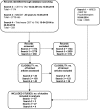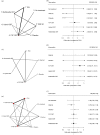The process and delivery of CBT for depression in adults: a systematic review and network meta-analysis
- PMID: 31179960
- PMCID: PMC6712954
- DOI: 10.1017/S003329171900120X
The process and delivery of CBT for depression in adults: a systematic review and network meta-analysis
Abstract
Cognitive-behavioural therapy (CBT) is an effective treatment for depressed adults. CBT interventions are complex, as they include multiple content components and can be delivered in different ways. We compared the effectiveness of different types of therapy, different components and combinations of components and aspects of delivery used in CBT interventions for adult depression. We conducted a systematic review of randomised controlled trials in adults with a primary diagnosis of depression, which included a CBT intervention. Outcomes were pooled using a component-level network meta-analysis. Our primary analysis classified interventions according to the type of therapy and delivery mode. We also fitted more advanced models to examine the effectiveness of each content component or combination of components. We included 91 studies and found strong evidence that CBT interventions yielded a larger short-term decrease in depression scores compared to treatment-as-usual, with a standardised difference in mean change of -1.11 (95% credible interval -1.62 to -0.60) for face-to-face CBT, -1.06 (-2.05 to -0.08) for hybrid CBT, and -0.59 (-1.20 to 0.02) for multimedia CBT, whereas wait list control showed a detrimental effect of 0.72 (0.09 to 1.35). We found no evidence of specific effects of any content components or combinations of components. Technology is increasingly used in the context of CBT interventions for depression. Multimedia and hybrid CBT might be as effective as face-to-face CBT, although results need to be interpreted cautiously. The effectiveness of specific combinations of content components and delivery formats remain unclear. Wait list controls should be avoided if possible.
Keywords: Cognitive-behavioural therapy; depression; multimedia; network meta-analysis; systematic review.
Figures




References
-
- Beck AT (2005) The current state of cognitive therapy: a 40-year retrospective. Archives of General Psychiatry 62, 953–959. - PubMed
-
- Blackburn I, James I, Milne D, Baker C, Standart S, Garland A and Reichelt F (2001) The revised cognitive therapy scale (CTS-R): psychometric properties. Behavioural and Cognitive Psychotherapy 29, 431–446.
-
- Bridges S (2014) Mental health problems. Health Survey from England. Leeds, England. Available at http://healthsurvey.hscic.gov.uk/media/37739/HSE2014-Ch2-Mental-health-p....
-
- Butler AC, Chapman JE, Forman EM and Beck AT (2006) The empirical status of cognitive-behavioral therapy: a review of meta-analyses. Clinical Psychology Review 26, 17–31. - PubMed
-
- Button KS, Wiles NJ, Lewis G, Peters T and Kessler D (2012) Factors associated with differential response to online cognitive behavioural therapy. Social Psychiatry and Psychiatric Epidemiology 47, 827–833. - PubMed
Publication types
MeSH terms
Grants and funding
LinkOut - more resources
Full Text Sources
Medical

